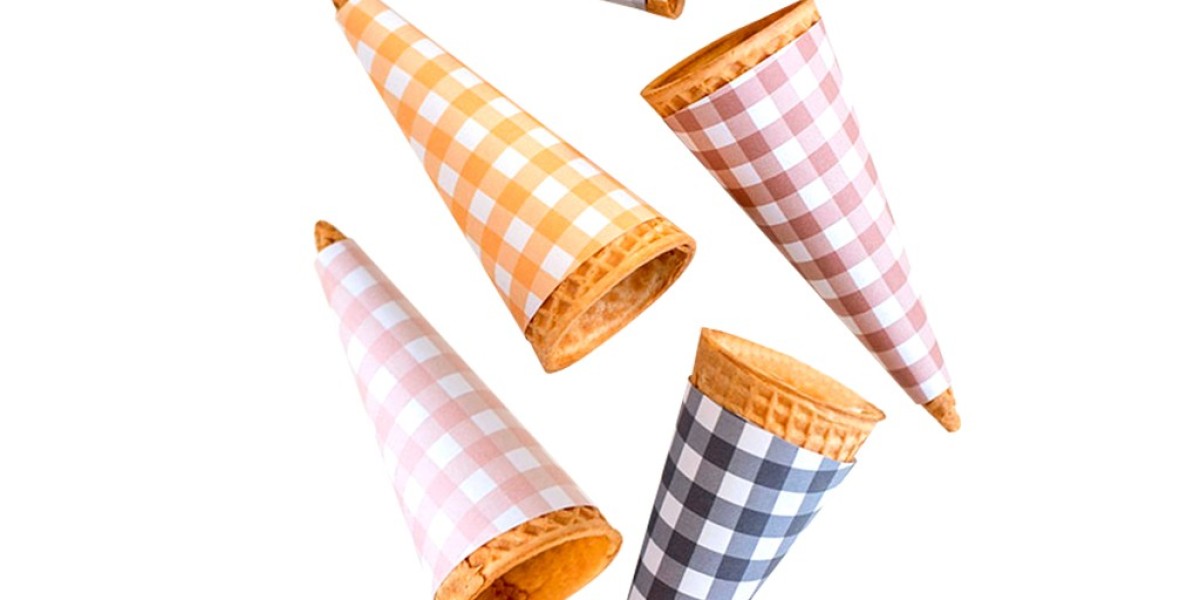Creating custom cone sleeves is an excellent way for ice cream businesses to elevate their brand, attract attention, and leave a lasting impression on customers. One of the key considerations in producing high-quality custom cone sleeves is selecting the right printing method. Two popular printing options for custom cone sleeves are PMS (Pantone Matching System) and CMYK (Cyan, Magenta, Yellow, and Key/Black). Each method has its unique strengths and is suited for specific design needs. In this article, we’ll explore PMS and CMYK printing, their pros and cons, and how to choose the best method for your custom cone sleeves.
Understanding PMS and CMYK Printing
What is PMS Printing?
PMS stands for Pantone Matching System, a standardized color matching system used in the printing industry. Each Pantone color is identified by a unique number, ensuring precise color consistency across different printing jobs and materials. PMS is often used for designs that require exact color replication, making it ideal for maintaining brand colors.
Key Features of PMS:
- Color Accuracy: Offers exact color matching, ensuring that the shade on your custom cone sleeve matches your brand colors perfectly.
- Consistency: Provides uniformity in color, which is crucial when using the same design across multiple batches and materials.
- Cost Efficiency for Limited Colors: Cost-effective when the design uses one or two specific colors, as there’s no need for full-color printing.
What is CMYK Printing?
CMYK stands for Cyan, Magenta, Yellow, and Black, the four primary inks used in this printing process. Unlike PMS, CMYK is a subtractive color model where these four inks are combined in varying proportions to produce a wide range of colors. CMYK is ideal for complex, full-color designs and is the most common printing method used in packaging.
Key Features of CMYK:
- Versatility: Capable of producing a broad spectrum of colors, making it suitable for intricate designs with multiple shades and gradients.
- Ideal for Photographic Printing: Best for designs that include photos, illustrations, or multicolor graphics.
- Cost-Efficient for Full-Color Designs: While it may not be cost-effective for designs requiring exact color matching, it’s ideal for vibrant and dynamic images.
Comparing PMS and CMYK for Custom Cone Sleeves
1. Color Consistency and Accuracy
For businesses looking to maintain strict brand consistency, PMS is often the preferred choice. The Pantone system ensures that your chosen color is replicated exactly as intended, whether you’re printing cone sleeves, business cards, or promotional materials.
- PMS Advantage: Provides precise color matching, making it ideal for designs that include your brand’s specific shades or logos.
- CMYK Limitation: Colors can vary slightly depending on the printer, paper type, and other factors, making it less reliable for exact color matching.
When to Choose PMS: Use PMS for designs where brand identity and consistent color reproduction are crucial, such as when using distinct brand colors like Coca-Cola’s red or Starbucks’ green.
2. Design Complexity
If your custom cone sleeve design includes multiple colors, gradients, or photographic elements, CMYK is the superior option. CMYK printing can blend colors to create realistic images and vibrant multicolor graphics, something that PMS cannot achieve effectively.
- CMYK Advantage: Perfect for complex, high-resolution images and designs with subtle shading and transitions.
- PMS Limitation: Limited to solid colors without the ability to create smooth color gradients or complex images.
When to Choose CMYK: Use CMYK for designs that involve detailed illustrations, intricate patterns, or a mix of multiple colors.
3. Cost Considerations
Cost is another critical factor when choosing between PMS and CMYK. PMS is more cost-effective for simple designs using one or two colors but becomes expensive as the number of colors increases. CMYK, on the other hand, is designed for full-color printing, making it a cost-effective choice for vibrant, detailed designs.
- PMS Advantage: Economical for single or dual-color designs.
- CMYK Advantage: Better for full-color designs, especially when using high-quality imagery.
When to Choose PMS: For simple, minimalist designs with one or two solid colors. When to Choose CMYK: For vibrant, multicolor designs with gradients or photo-realistic images.
4. Print Run Size
The size of your print run can also influence which method is more practical. For small runs, PMS can be more expensive due to the setup costs involved. CMYK, however, is cost-effective for both small and large print runs, especially if the design uses a mix of colors.
- PMS Drawback: Higher setup costs for small print runs.
- CMYK Advantage: More affordable for both small and large quantities.
When to Choose PMS: Large-scale production where exact color consistency is needed. When to Choose CMYK: Small to medium-sized runs with detailed designs.
5. Eco-Friendliness
Sustainability is becoming increasingly important for businesses. Both PMS and CMYK printing can use eco-friendly inks, but PMS has the upper hand when it comes to controlling waste and emissions. With PMS, only the necessary colors are used, whereas CMYK involves multiple ink combinations, which can lead to higher wastage.
- PMS Advantage: Less ink waste and lower environmental impact.
- CMYK Limitation: Potentially higher waste due to multiple ink combinations.
When to Choose PMS: If eco-friendliness and minimal waste are top priorities. When to Choose CMYK: When you’re able to source eco-friendly CMYK ink solutions.
Best Practices for Using PMS and CMYK on Custom Cone Sleeves
Combine PMS and CMYK for Optimal Results
For designs that require both exact color matching and vibrant, full-color elements, combining PMS and CMYK can be the best approach. This hybrid printing technique allows you to use PMS for key elements like logos and CMYK for backgrounds, gradients, or photos.
Example Use Case: An ice cream shop wants to maintain its distinct brand color on the sleeve while also including a colorful image of an ice cream sundae. Using PMS for the brand color and CMYK for the sundae image can create a visually appealing sleeve that meets both needs.
Consider the Material of the Cone Sleeve
The type of paper or material used for the cone sleeve can affect how the colors appear. Glossy finishes can enhance the vibrancy of CMYK prints, while matte finishes might mute certain shades. PMS colors can also look different depending on the material. Always test print on the actual material to ensure the final product meets your expectations.
Use Spot Coating to Highlight Design Elements
When using CMYK, consider adding spot coating or UV treatment to specific areas of the cone sleeve to make certain elements stand out. This technique can create a striking visual contrast and add texture, making your cone sleeves more engaging and visually appealing.
Conclusion
Choosing between PMS and CMYK for custom cone sleeves depends on your specific design needs, brand requirements, and budget. PMS is the best choice for brands that prioritize color consistency and accuracy, while CMYK excels in producing vibrant, complex designs. By understanding the strengths of each printing method, you can select the one that aligns with your brand’s vision and enhances the overall appeal of your custom cone sleeves.
When in doubt, consult with your printer or packaging provider to determine the ideal method for your project. With the right approach, your custom cone sleeves will not only serve as practical holders for ice cream but also as powerful tools for brand promotion and customer engagement.









